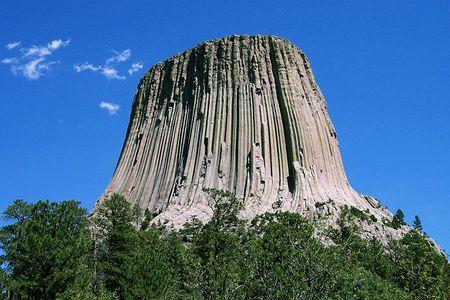The Antiquities Act of 1906 authorized the president to create national monuments by presidential proclamation. Since then, presidents have invoked the act to protect numerous sites with nationally significant natural and cultural resources. Here are some salient statistics..
2.03 million acres
Total area of the national monuments in the National Park System. That's nearly 3,600 square miles.
140,000 square miles
Area of Papahānaumokuākea Marine National Monument, the largest protected area proclaimed under authority of the Antiquities Act. Larger than all but four states, this national monument was proclaimed by President George W. Bush in 2006. It is co-administered by NOAA and the U.S. Fish and Wildlife Service.
5,000 acres
Maximum size of a national monument that a president may proclaim in Alaska without first getting the explicit consent of Congress. The 1980 Alaska National Interest Lands Conservation Act (ANILCA) included this stipulation, which was prompted by President Jimmy Carter's use of the Antiquities Act in 1978 to proclaim 15 national monuments in Alaska totaling 56 million acres.
840 miles
Approximate length of the BLM-managed California Coastal National Monument, which protects all islets, reefs, and rock outcroppings with 12 nautical miles along the entire coast of California.
100
Number of national monuments. Proclamations and redesignations cause the count to change frequently.
75
National monuments in the National Park System. The National Park Service manages or co-manages three-quarters of the extant national monuments, which is a far larger share than any other federal agency.
55
National monuments created primarily to preserve natural resources such as geologic, marine, and volcanic sites.
27
States with national monuments. There are also national monuments in American Samoa, the Virgin Islands, the Minor Outlying Islands, and the Northern Mariana Islands.
22
National monuments established to preserve Native American sites, such as Ancestral Puebloan ruins in the Southwest.
19
National monuments proclaimed by President Bill Clinton during his two terms of office. He proclaimed seven of these in 2001 just before he left office.
18
National monuments in Arizona, which has the most of any state. Next come New Mexico (12) and California (10).
15
Presidents who have invoked the Antiquities Act to proclaim national monuments. Since the Antiquities Act became law in 1906, all but three presidents -- Richard Nixon, Ronald Reagan, and George H. W. Bush -- have used it to proclaim national monuments.
7
National Monuments in the National Park System with "fort" as part of their official name. This category includes Fort Frederica, Fort Matanzas, Fort McHenry, Fort Pulaski, Fort Stanwix, Fort Sumter, and Fort Union National Monuments.
6
Federal agencies that administer or co-administer national monuments. In additional to the National Park Service, national monuments are administered or co-administered by the Bureau of Land Management (16), the U.S. Forest Service (6), the U.S. Fish & Wildlife Service (6), The Armed Forces Retirement Home (1), and the National Oceanic and Atmospheric Administration (1).
5
National monuments co-administered by more than one federal agency. The National Park Service co-administers three national monuments, including two with the Bureau of Land Management (Craters of the Moon and Grand Canyon-Parashant) and one with the Fish & Wildlife Service (World War II Valor in the Pacific)..
0
National monuments that can be created or expanded by presidential proclamation in Wyoming without the express permission of the state of Wyoming. Congress granted this concession to Wyoming (via a 1950 amendment to the Antiquities Act) after state residents vehemently objected to the proclamation of Jackson Hole National Monument in 1943.




Comments
The only "Park" designation I recall is Anacostia Park in D.C. Doing a little research, there appear to be a total of 7 places designated "Park" as part of National Capital Parks - East. Are they really separate units though?
@MM: Great find. Yes, President Lincoln and Soldiers' Home National Monument is situated in Washington D.C. And I could not find it, because it is not a unit of the NPS but administrated by the National Trust for Historic Preservation for the Armed Forces Retirement Home. But it is a designated National Monument, so Bob's original listing of D.C. was correct and should be restored. I stand corrected and have learned something new.
I am on vacation and not accepting challenges. I will chip in President's Park, though, just to keep this thread going. Bob Janiskee
@tomp
Don't forget the "National Scenic Riverways", such as Ozark and St. Croix.
Great Falls Park
Catoctin Mountain Park
The NPS lists that Pres. George H. W. Bush established Petroglyph National Monument on 6/27/90. Why does the paragraph above say he was one of 3 presidents who didn't use the antiquities act to create monuments? Did he establish it some other way?
Not all national monuments have been established by presidential proclamation, Anon. Some have been established by Act of Congress. Petroglyph National Monument is one example. President Bush signed the bill into law.
Thanks Bob! Let me add some words of our president
Franklin D. Roosevelt:
"There is nothing so American as our national parks.... The fundamental idea
behind the parks...is that the country belongs to the people, that it
is in process of making for the enrichment of the lives of all of us."